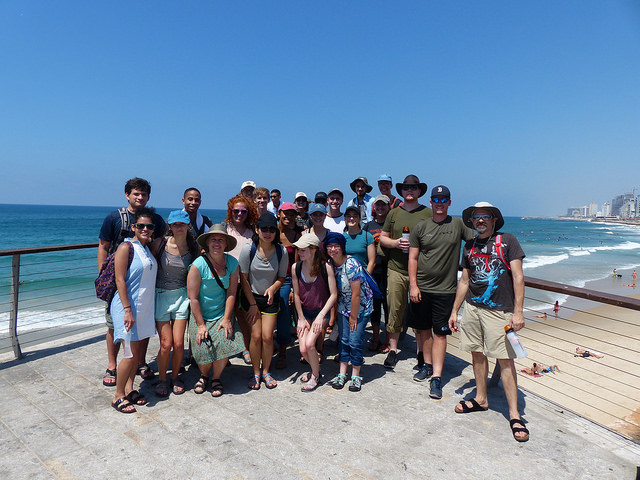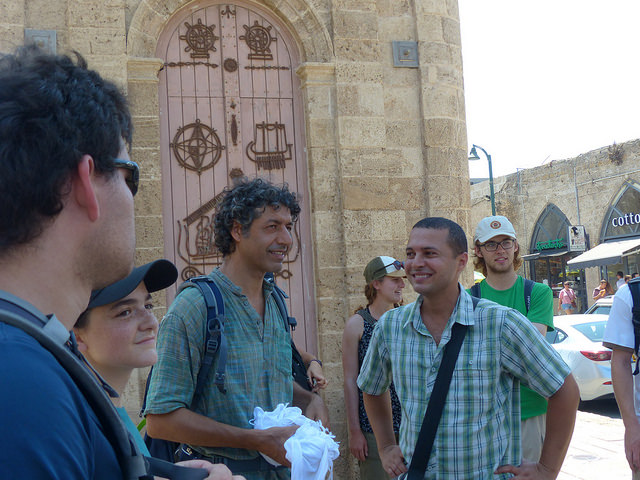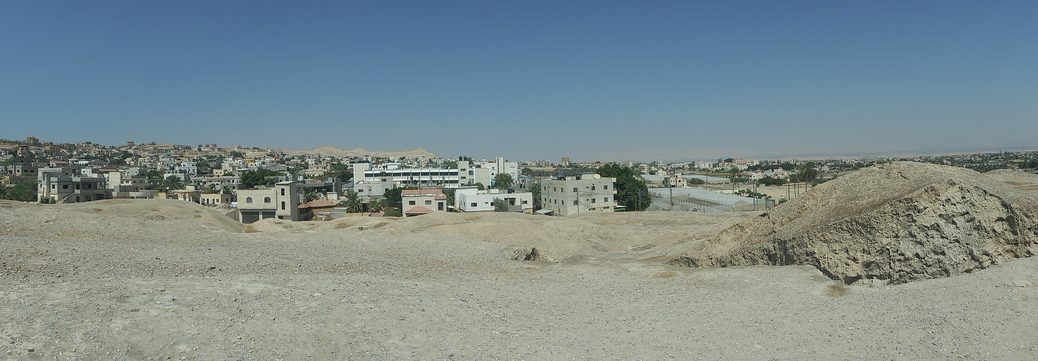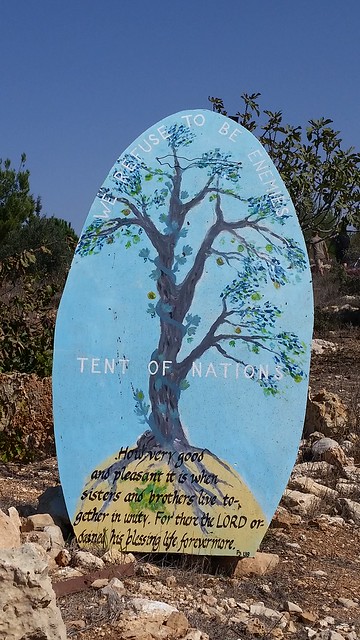Sore Feet
Saturday, September 2, 2017: Tel Aviv, Jaffa
Shalom! Here we are in Tel Aviv, Israel. Our feet have carried us for 29 hours in this exotic city. My first impressions of this land: The sand is hot, the sun brilliant, the skin leather. I feel as if our foreign presence is obvious. We walk around dripping with sweat like everyone else and we squint from the overbearing light – just like everyone else – but the lingering stares from the locals feel heavy (I think it is because of our Chacos, water bottles, and backpacks!).

Now, I hesitated to substitute the word “locals” with “natives” because of Israel’s distinct and complicated history. In Tel Aviv, it is different because every religion, style of dress and language is welcomed with open arms. However, the Israeli-Palestinian conflict is ever-present. To put it simply (and pleasantly), Arabs lost their homes when the Jews arrived, yet the Jews fulfilled their prophecy to acquire the Holy Land. There seems to be a silent tension when the conflict is discussed from a one-sided perspective. I have been feeling as if the people that speak to us about their opinions are not spilling all that lies on their hearts. Instead of being open minded, it seems to me that most people we have encountered maintain their stagnant, silent attitude and avoid discomfort at all costs. When our group walked down the coast to Jaffa – a one hour walk south of Tel Aviv – it felt like were the only people in the streets.
Our guides, Elad (Moroccan Jewish) and Alaa (Palestinian, Israeli citizen and a graduate of EMU’s Center for Justice and Peacebuilding program), explained in a careful tongue that Old Jaffa holds burdensome Arab Palestinian history, which entails a negative connotation for the Jewish Israelis. Despite this, most Palestinian homes in Old Jaffa have been repurposed into boutiques that overflow with vivid paintings, jewelry, spices, and napping street-cats. It hurts me to know what happened to the Palestinians who used to call these places home.
Even in the most shadowed corners of Old Jaffa, the winding stone walls still prove capable of absorbing the brilliant heat. It is a port town, aging close to 5,000 years. Each stone path is chipped with biblical history. On our first full day in Israel, our feet have carried us across sand where the disciples once walked. We have waded in warm Mediterranean waves, stuttered our newly-learned languages of Hebrew and Arabic, and seen the house of Simon the Tanner where Peter slept after he raised Tabitha from the dead, and where he had a vision from God commanding him that “what God has cleansed you must not call common” (Acts 10:15).
Our feet ache with heartbeats of a new adventure, and our mouths still fall agape at the sight of this beautiful land. I feel overwhelmed with this unfamiliar place, its deep internal conflict, the languages, and the stares. I do not have much to say about our first week in Israel. My mind, however, proves opposite of my mouth. It has become feral like the Israeli street cats – constantly stirring and pulling up emotional garbage – and I can’t seem to twist my thoughts into comprehensible words. Regardless, I have an immense hope for the good that could come from this diverse desert. The friendships I am forming hold a sense of genuineness I have rarely felt before. I will move onward, Insha’Allah (Arabic for “if Allah allows” or “God willing”) to tomorrow, where our feet will further carry us in the Holy Land.
-Larissa Graber
Contradictions
Sunday, September 3, 2017: Tel Aviv, Neve Tsedek, Jisr Az Zarqa
Walking through the streets of Tel Aviv we hear a different narrative from the day before. Our guide, Abraham Silver, a long-time resident of Israel with American Jewish roots presents the story of a youthful city with a history of only 107 years, started mainly by people in their teens and low 20s. Yes, 60 families, mostly made up of people our age helped to build the first Jewish city in what would become Israel. Abraham shows us a picture of the families, on a sand dune, with a barren landscape behind them, waiting to be tamed.
Walking through Tel Aviv we look up into glass buildings that reach new heights. We walk on sidewalks that cover old sand dunes. The “New York of Israel” is a success story woven with the pain and fear of a thousand years of living in ghettos and fleeing pogroms. We feel the effects of massacres in Rome, Spain, Kishinev (Google it), and across Europe. All is cross-stitched with the bravery, imagination, and the stubborn (blind) determination only present in teenagers. Israel was founded by young adults with nothing to lose. Moving to the U.S. would have been the responsible choice, with job opportunities, family, and pre-existing, thriving Jewish communities. Israel was the dreamer’s choice. The end result is a victorious fairy tale that overshadows all else. Our guide stood in the center of Neve Tsedek, the first neighborhood of Tel Aviv, proudly singing the song of a found people.
The tale continues to be one success after another. We see the houses where the founders of the modern Hebrew language took a biblical tongue not spoken for more than prayers in 400 years and developed a colloquial language so that the eventual nation (already dreamed of by this time) could have its own language. We stand in the middle of a metropolitan sprawl looking at a tiny cappuccino kiosk, what had originally been the very first building of Tel Aviv. We sit in front of the first Jewish school for girls, one of many examples of the revolutionary Israelis. Finally, our guide tells us, “The Jews have a home. Finally, we are safe.” But there is a lot more to the story that we find out later. For instance, that picture of those first 60 families, standing on a sand dune, with nothing but empty space behind them. We later find out that had the photo panned to the left or the right we would have seen the Palestinian villages that already existed in this “empty land”.
Who do we believe? How can we get the full story? That is what we are here to do. And it is hard work . . . if it is even possible.
The contradictions continue as we learn about different types of peacebuilding efforts by Israelis and Palestinians and organizations made up of both. The Shimon Peres Institute for Peace and Innovation (started by Shimon Peres, former Prime Minister and President of Israel) swears that relationships are the keys to peace. But their building is built facing the seafront, blocking the view of Palestinians living behind it and very close to a Palestinian cemetery. Zochrot, the second institution that we toured, vows that there cannot be peace without justice – allowing Palestinians the option of returning to the land they were forced to leave. They have created a map that shows the Palestinian villages emptied or destroyed in 1948 during the “Nakba” (Arabic for “catastrophe”) when Israel became a nation.

The third institution we saw, Beit HaGafen, works with the shared humanity of art. Then we visited Jisr Az Zarqa, a poor Palestinian city in Israel, where recent development and tourism attempts show potential to bring better economic conditions to this town of 40,000 people.
Next to this, we hold within us frustrations over the language barrier and the joys of having fun with friends. We are still college students learning what it means to live in this world. We are sleepy and excited, exhausted and rejuvenated. We have more questions than answers, more processing in the works, and we all share a deep sense of something. When we figure out what it is, we’ll let you know.
-Lindsay Acker
Indiana Jones was Just a Movie
Wednesday, September 6, 2017: Jericho
Tuesday night we said goodbye for a few weeks to our guide Alaa after a day’s tour of his home city of Akko. Wednesday morning we left Haifa on our faithful modern-chariot [bus with air conditioning] for the old and new city of Jericho. We pulled into a quiet gas station just outside of Jericho and if not for the signs being in Arabic and Hebrew and the presence of several camels, it would be hard to tell that we are not in the American Southwest. After refueling and picking up our new guide, a local man named Hamudi, we drive into Jericho. Before crossing into the city limits (which are controlled by the Palestinian Authority), we must first part ways with our Jewish guide, Elad,. Regardless of how badly we want him to accompany us and vice versa, it is illegal for him (and all other Israeli Jews) to enter Jericho, which is part of the Palestinian Authority known as “Area A” (for more information on who controls which part of the West Bank, click here). It is with heavy hearts that we must continue without these two guides, who have quickly become friends. This is one of the first tangible lessons of the conflict. Shortly after leaving Elad we get our first true glimpse of the “Palestinian State”.Jericho is a cluttered canvas splattered with shades of grey, beige, and off-white. In some places it looks like a public service announcement about the developing world and in others a modern city. One of the most obvious signs of tension between economic development and stagnation is an “Oasis Hotel” and a casino – a massive, beautiful, modern building with doors locked tight and only “guests” allowed to enter. Unsurprisingly, the potential for explosive conflict is bad for the once growing business and has driven away much of the casino’s former clients, providing an even more powerful reminder of the stranglehold Israel has on Palestinian territories.
After a lunch of delicious shwarma (meat wrapped in a pita with various sauces and vegetables) or falafel (fried balls of chickpea and spices, wrapped in pita with various sauces and vegetables) we head to the tree that Zacchaeus the tax collector climbed to see Jesus as he passed by in Jericho. Today the tree is like so many other sites in the modern Holy Land – a tourist trap. A local vendor hawking his wares stopped to tell us the story before immediately returning to enticing us with scarves and trinkets. As thanks for the story, a few of us bought head scarves or other small items. I was personally pulled aside by a man selling dates and after some intense negotiation, I passed on his product which I knew was overpriced. I have to this point left out an essential character in our story, Ibrahim, our long suffering bus driver. Ibrahim is a man of few words, speaking only softly and seldom. Despite being quiet, his driving is anything but. After boarding the bus again, Ibrahim takes us to an overlook below the Mount of Temptation, and displays his skill behind the wheel that would make Mario Andretti blush. Through a combination of grit, determination, and what I’m certain were a few Arabic curse words, our bus makes its way slowly up the steep and winding gravel-strewn slope to the overlook of the valley. Above us built into the cliffs is a large monastery belonging to the Greek Orthodox Church. Below us spread out across the valley floor is a tapestry of brightly colored patches of garbage that looked as though the sun has melted a million boxes of crayons. As lovely as the image might sound, it was far from beautiful. The vibrant realization was that the source of color was just human-strewn trash. After a few minutes of melting ourselves in the sun, we boarded our bus and Ibrahim once again showed his talent on the way back down the mountain.
Finally, we arrived at our last sight-seeing destination in Jericho: the archeological excavation of the old city of Jericho. It was at this moment my inner child (and inner Indiana Jones) was set loose. My joy, however, was short lived. Despite the ongoing excavation and restoration, the current site of Jericho is far from the lost cities and ancient temples Harrison Ford came upon. In part, this is due to the logistical challenges of excavating a place where temperatures typically exceed 100° Fahrenheit, electricity and water are spotty, and the conflict makes it difficult for archaeologists to get permission for new digs. I still found the walls and tower to be impressive, and the portions of the site that have been renovated are even more incredible when you consider that Jericho is more than 10,000 years old. Layer was built on top of layer, but the original stones and bricks that make up its early walls are easy to distinguish from the renovations.
Whether or not the site is accurate to the biblical Jericho or whether the story of Joshua and his famous battle has any truth is up for debate but I found it to be undeniably awe-inspiring. The longer we spent walking the grounds of the site the more my initial disappointment faded. This was the remains of the ancient city of Jericho! While there was certainly nowhere to practice my Indiana-Jones-bullwhip-skills or hidden passages to explore (thanks to ropes and chains surrounding all excavation pits), my childhood dreams of seeing the wonders of the ancient world were rekindled. As we left the town behind us, I reflected more on what it was that made me fall in love with history in the first place. It wasn’t some vain idea of being a “world adventurer” it was the idea of seeing the places where people had lived their lives and to have the opportunity to walk in their footsteps, experiencing their holy places, and perhaps most importantly, meeting people like Hamudi who told their stories and kept their myths and legends alive.
We read the Biblical stories of Jericho aloud as we headed to our next destination. It was a good closer for the experience.
Rejected blog titles:
While we have not actually settled on a blog title, we have developed quite a list of rejected titles. Many are inside jokes, so you will have to ask us for the story. We hope you enjoy them. We will add to the list as more are proposed and rejected:
- Armageddon has a gift shop (and we really only stopped to pee)
- We cried at Chinese food (and a dog)
- Hey Andy look at the cat!
- Uncle Bill’s paying
- There’s an essential oil for that
- It’s Hot (pronounced with phlegm)
- Uncle Bill, why can’t I put sunscreen on your back?
- “It’s 100 degrees at 8pm and they tell us the heat wave is still coming!”
- ANI DAVID !!!!!
Next week, keep following our adventure for thoughts about Kibbutz Ketura, the Arava Institute for Environmental Studies, and various other things that fall on our minds.
-Owen Musselman

